Africa is home to some of the most colossal creatures on the planet.
In Africa’s vast deserts, savannahs, tundras, and rainforests, extraordinary creatures contribute to the web of life. From the mighty African elephant to the towering giraffe, each species plays an essential role in maintaining the balance of their ecosystems.
Let’s take a look at the largest free-roaming animals in Africa’s wild landscapes.
African Elephant
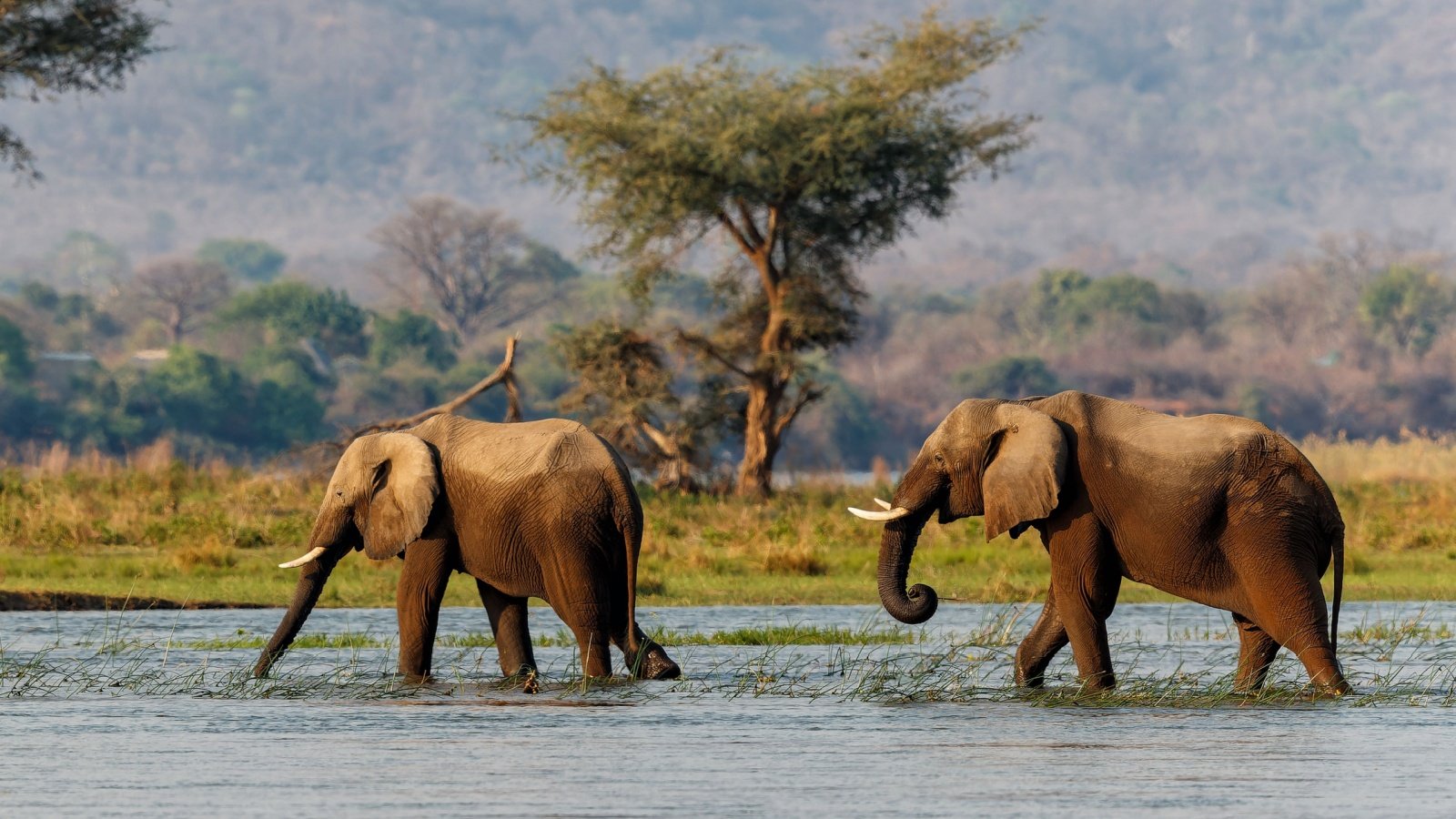
The African elephant, the largest land animal on Earth, can weigh up to 12,000 pounds and stands up to 13 feet tall at the shoulder. These majestic creatures are distinguished by their large ears, which help regulate their body temperature.
Leatherback Sea Turtle
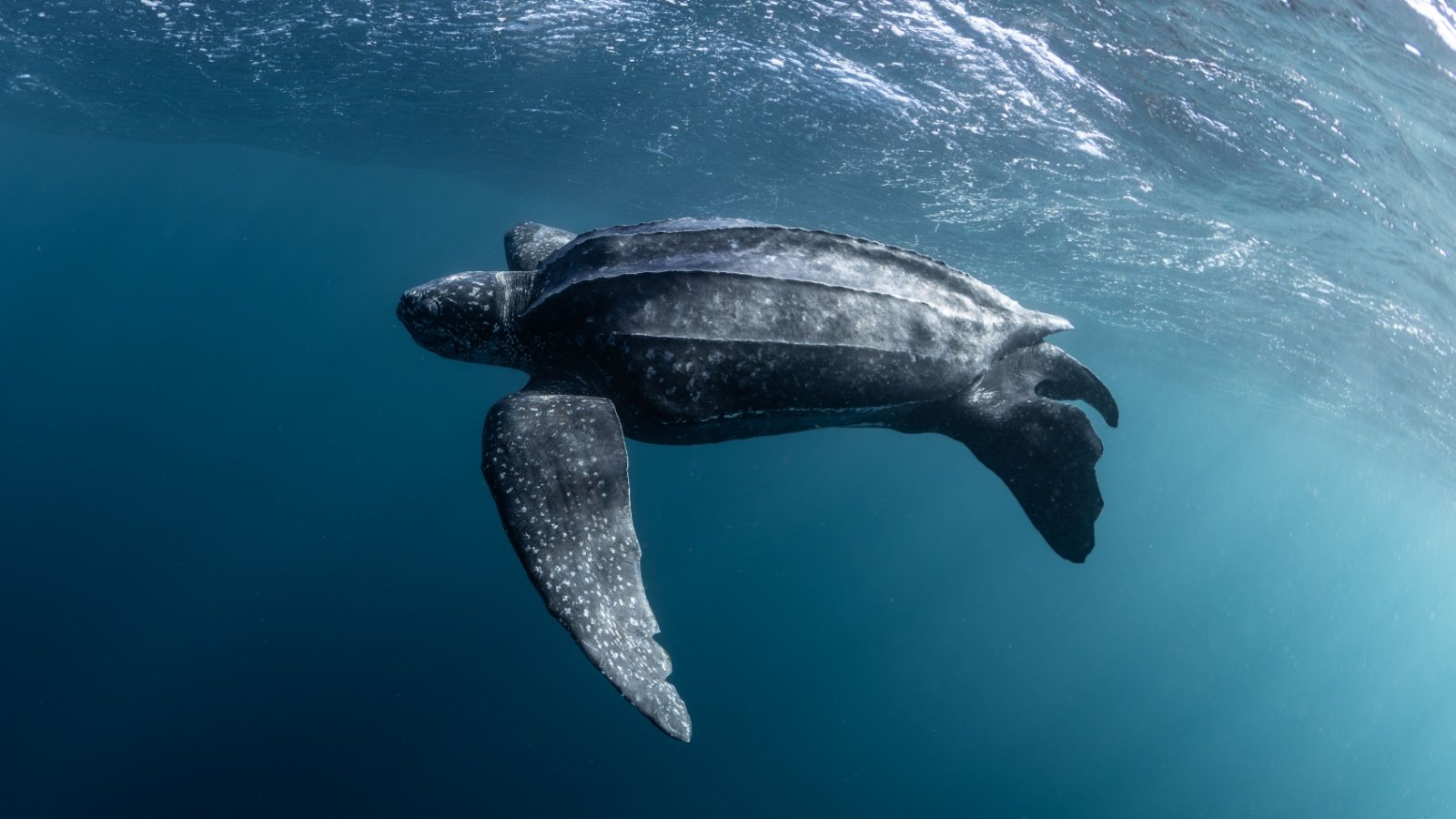
The leatherback sea turtle, the largest of all turtles, frequents African coasts. They can grow up to 7 feet in length and weigh over 2,000 pounds, primarily feeding on jellyfish. Leatherbacks undertake vast migrations between feeding and breeding grounds, which can span thousands of miles.
Spotted Hyena
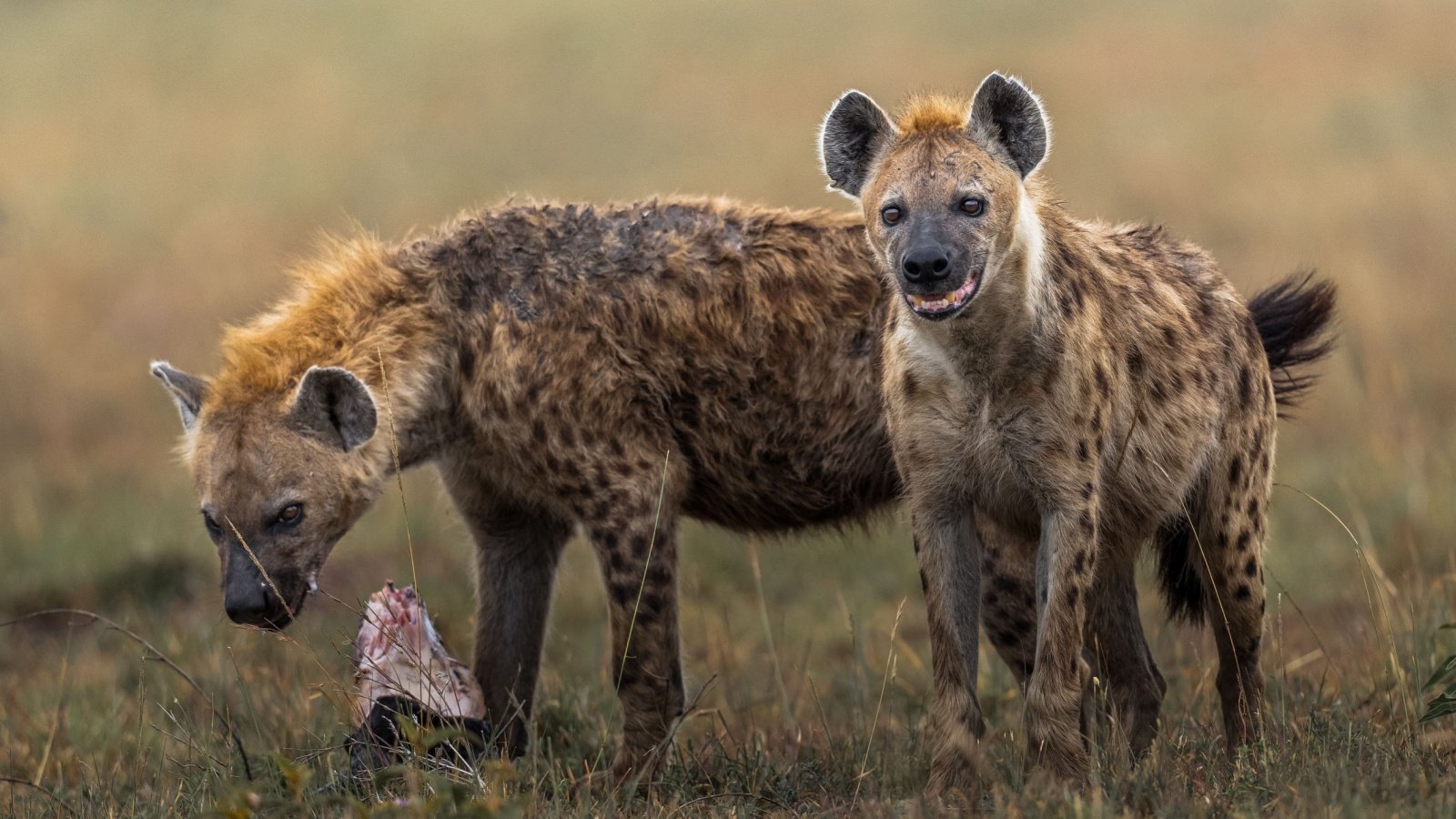
Though not the largest predator by weight, spotted hyenas are one of the most successful. Adult hyenas can weigh up to 190 pounds and are known for their powerful jaws. Hyenas are not just scavengers but skilled hunters who can take down wildebeest or antelope.
Atlas Moth
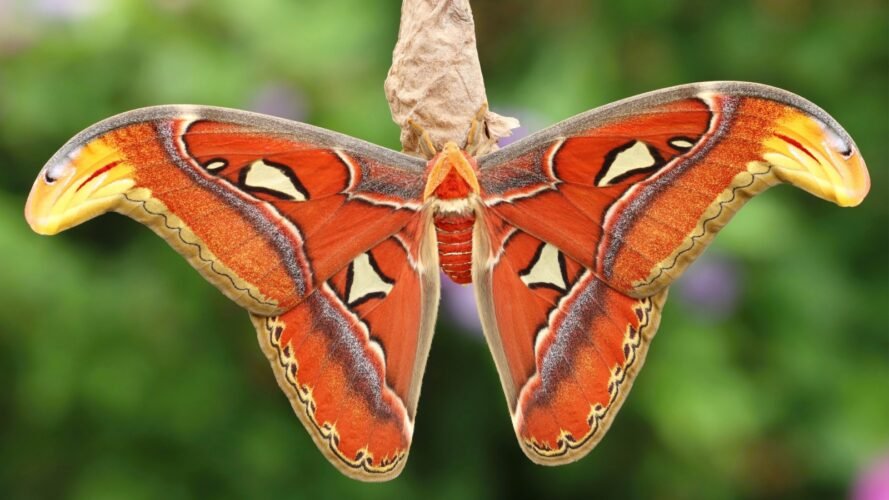
One of the largest moths in the world, the Atlas moth boasts a wingspan of up to 12 inches. They are found in the tropical and subtropical forests of Africa. Despite their size, Atlas moths have a very short lifespan, living only a few weeks, during which they do not eat, as they lack functional mouths.
Giraffe
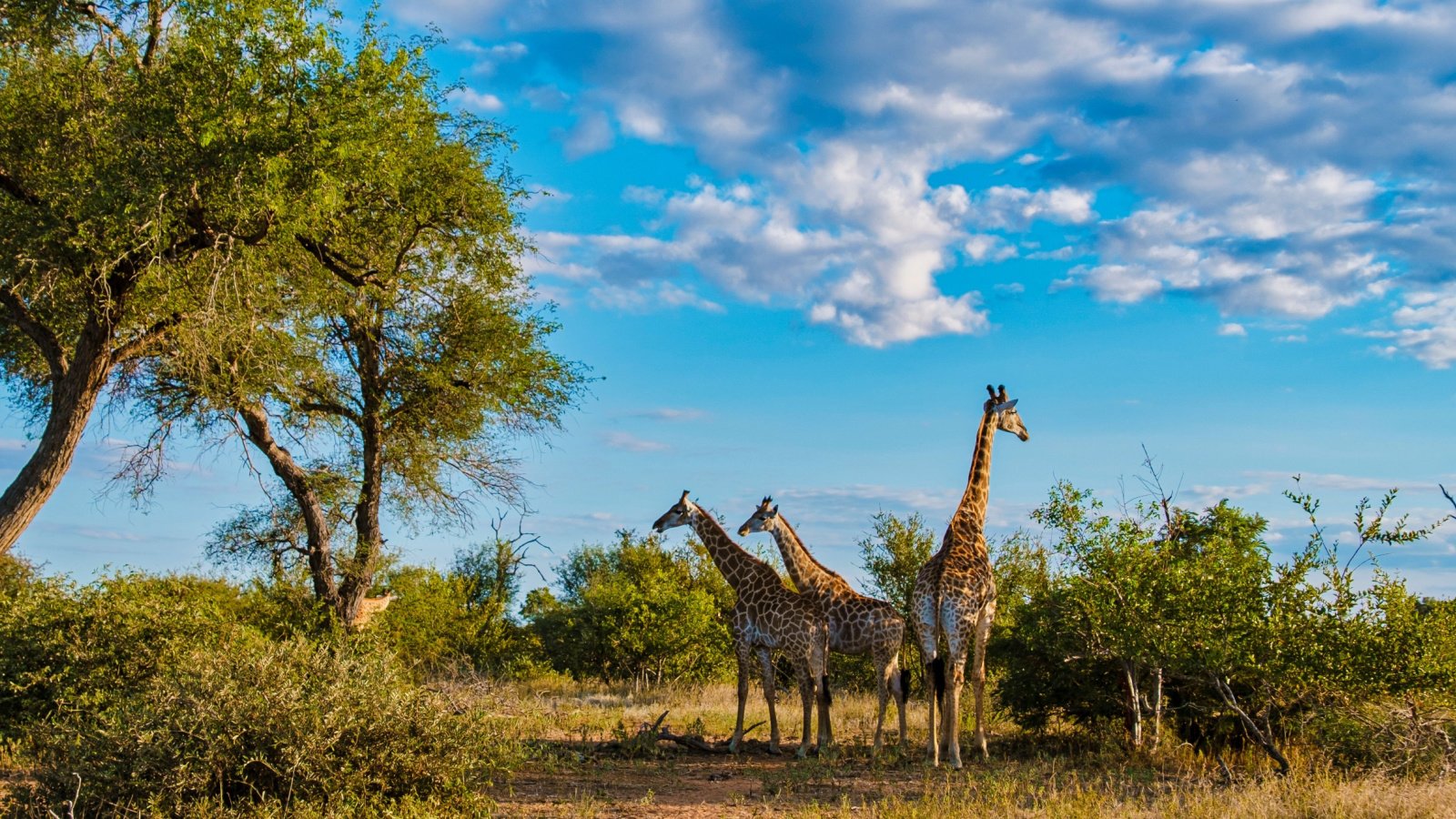
Giraffes are the tallest mammals in the world, with adults standing up to 18 feet tall. Their long necks and legs allow them to reach leaves high up in trees, giving them a dietary advantage in the savannahs and woodlands of Africa. Despite their height, giraffes can sprint up to 35 miles per hour to escape predators.
Hippopotamus
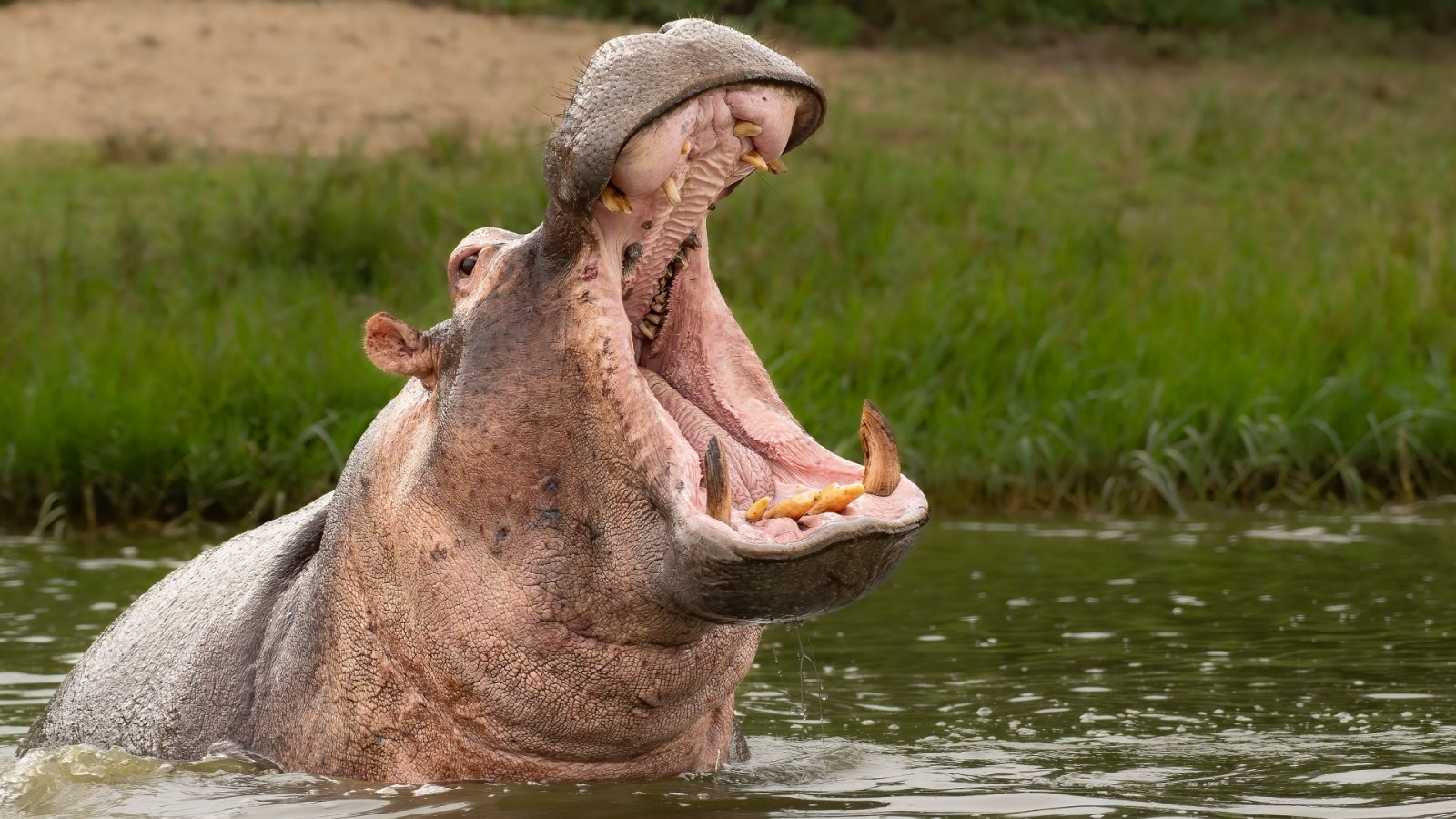
The hippopotamus is a large, mostly herbivorous mammal that can weigh up to 3,300 pounds. They spend much of their time submerged in rivers and lakes to keep their massive bodies cool under the African sun. Despite their stocky shape and short legs, hippos can run quickly and are highly aggressive if provoked.
White Rhinoceros
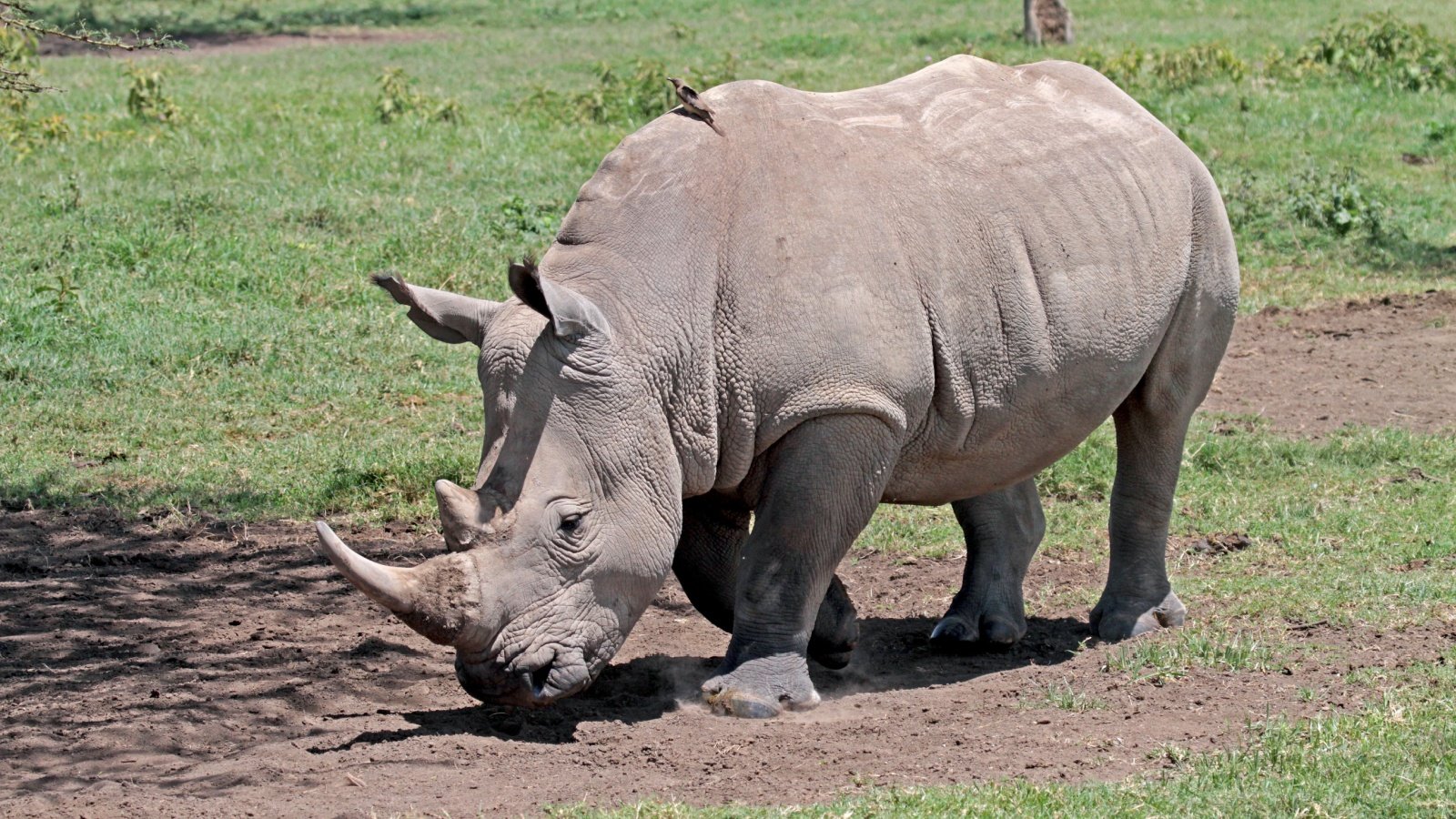
The white rhinoceros is one of the heaviest land mammals, with some males weighing over 5,000 pounds. Recognizable by their broad, square lips used for grazing, white rhinos are generally more social than their black rhino cousins.
Cape Buffalo
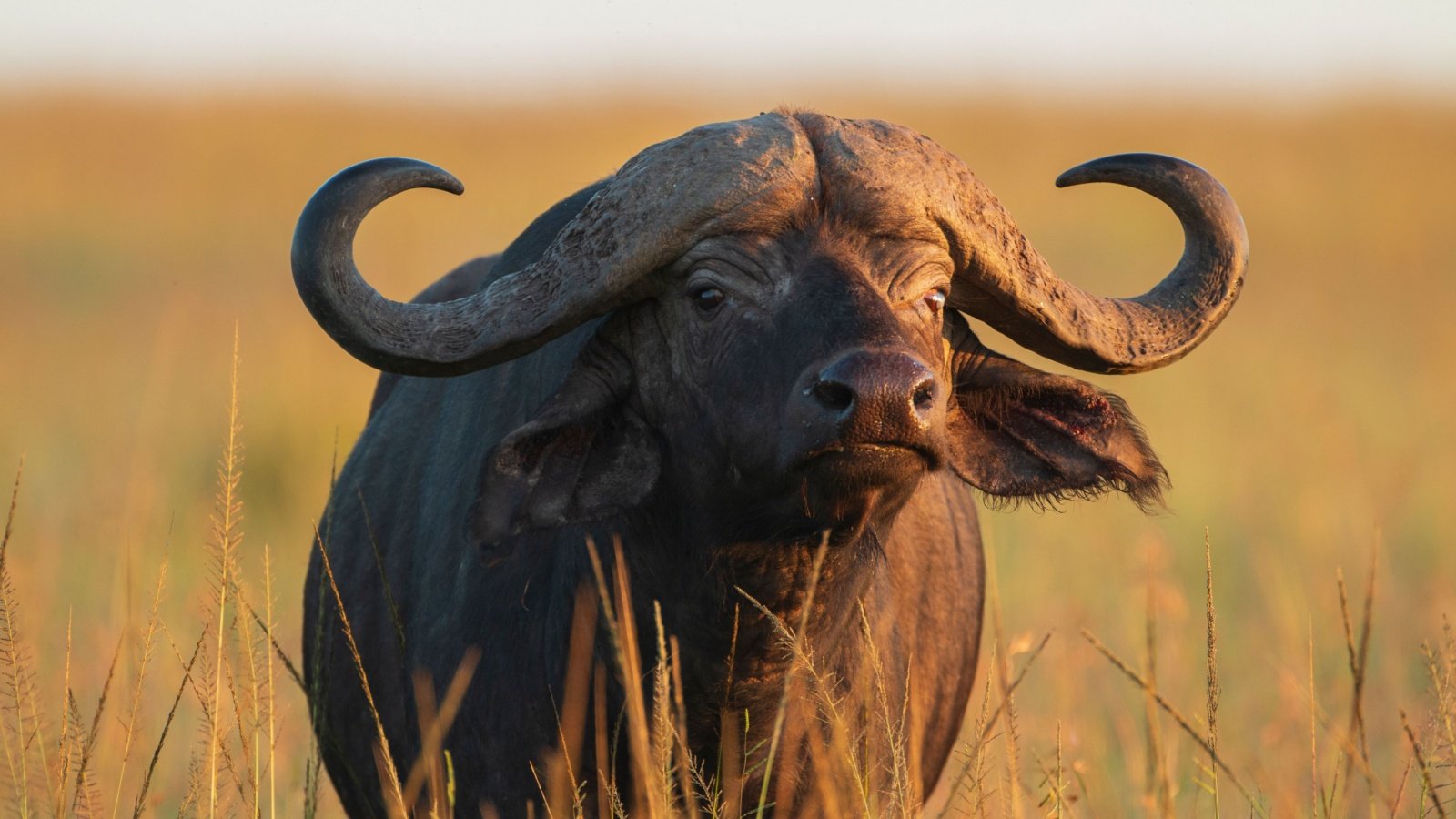
Cape buffaloes are robust animals, with large males weighing up to 2,000 pounds. Known for their unpredictable nature, they are considered one of the “big five” game animals in Africa. Buffaloes live in large herds in sub-Saharan Africa and are capable of defending themselves against most predators, including lions.
Nile Crocodile
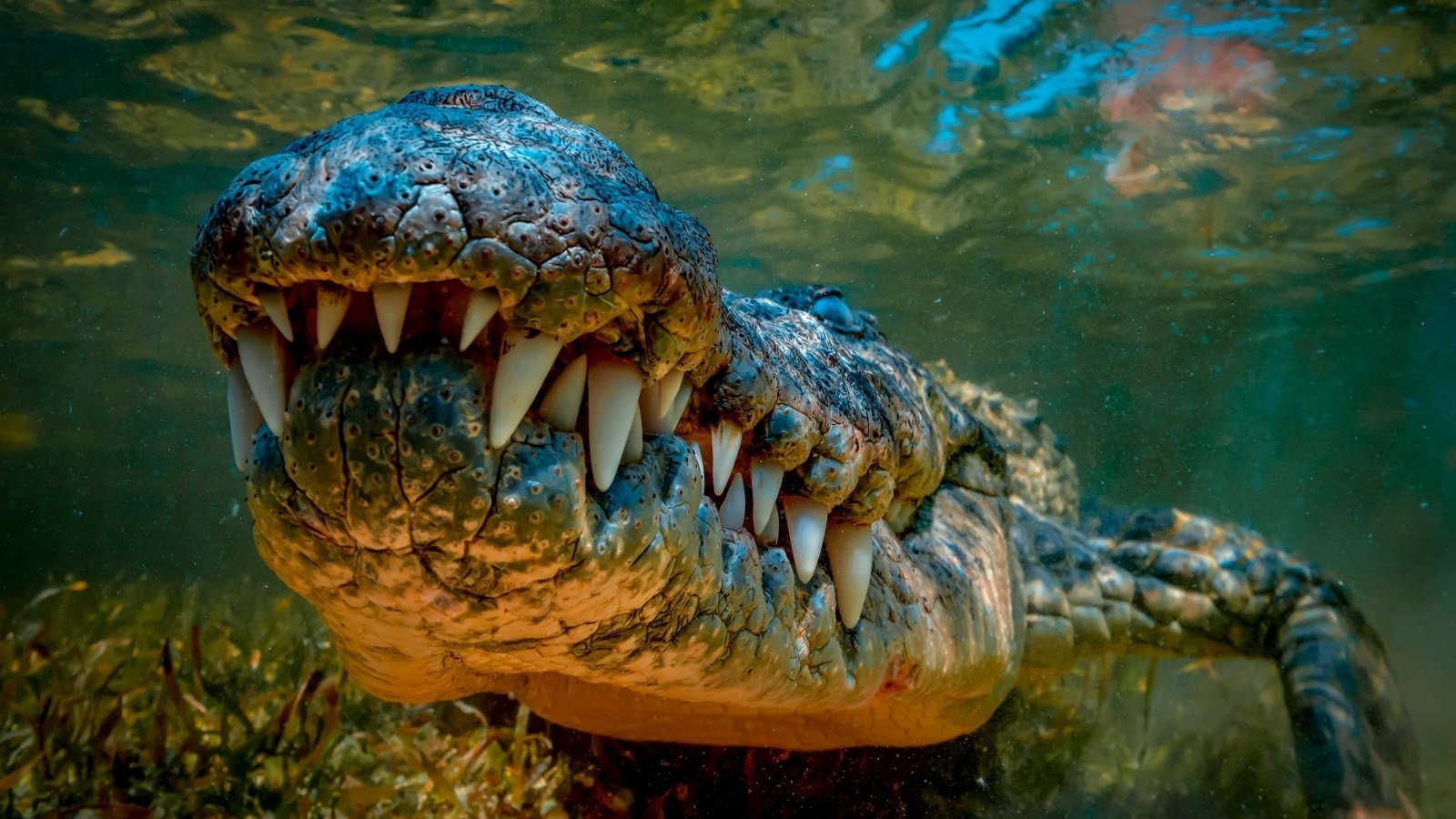
The Nile crocodile is Africa’s largest freshwater predator, reaching lengths of up to 20 feet and weighing as much as 1,650 pounds. These powerful reptiles are adept hunters, feeding on fish, birds, mammals, and occasionally even larger prey like buffalo. Nile crocodiles have a fearsome reputation attributed to their aggressive nature and lethal hunting techniques.
Ostrich
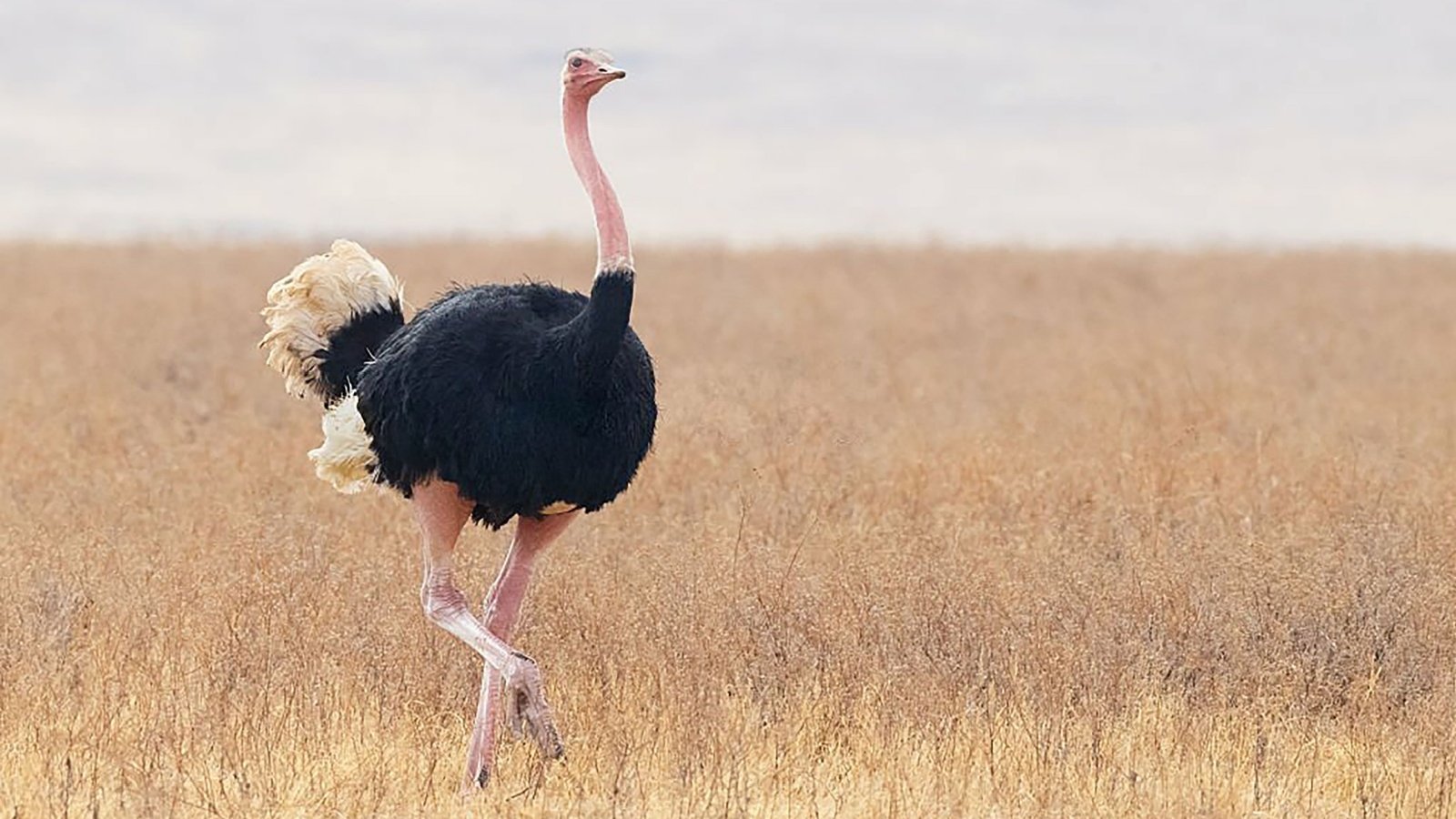
The ostrich is the world’s largest bird, standing up to 9 feet tall and weighing up to 344 pounds. They can’t fly, but their long legs allow them to sprint at speeds over 40 miles per hour. Ostriches are primarily found in African savannahs and are famous for their large eggs, which are the biggest of any living land animal.
Southern Ground Hornbill
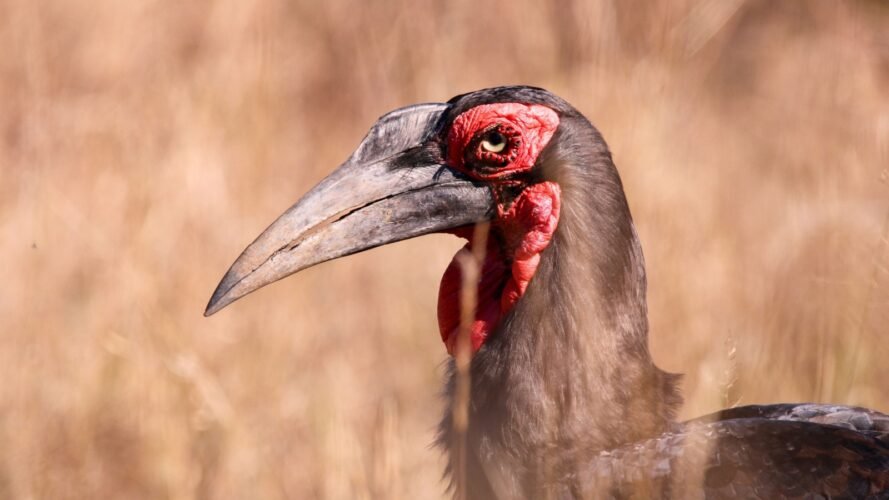
This large bird, distinctive with its black coloration and vivid red face and throat patches, can weigh up to 13.6 pounds. The Southern Ground Hornbill is a formidable predator, feeding on insects, snakes, other birds, and small mammals. They can live up to 70 years in captivity.
Kori Bustard
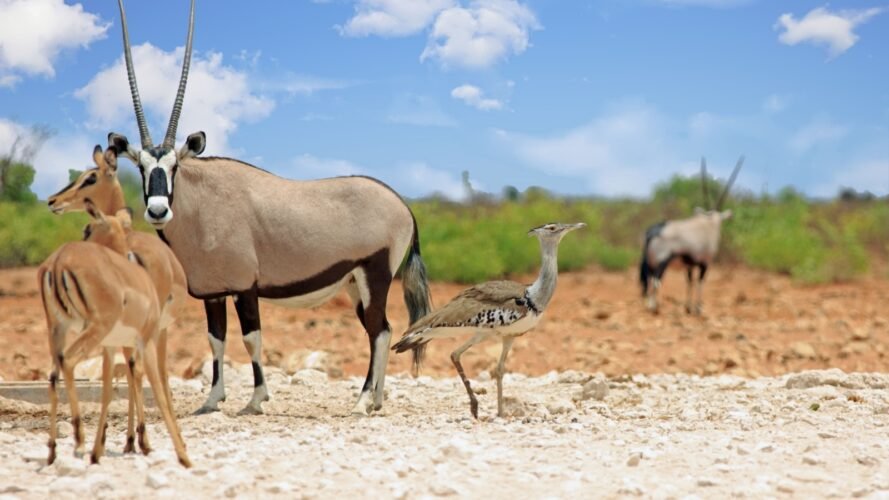
The kori bustard may be the heaviest bird capable of flight, with males weighing up to 40 pounds. These birds are found throughout southern Africa and are known for their impressive displays during mating seasons. They feed on a variety of insects, small animals, and plants.
Common Eland
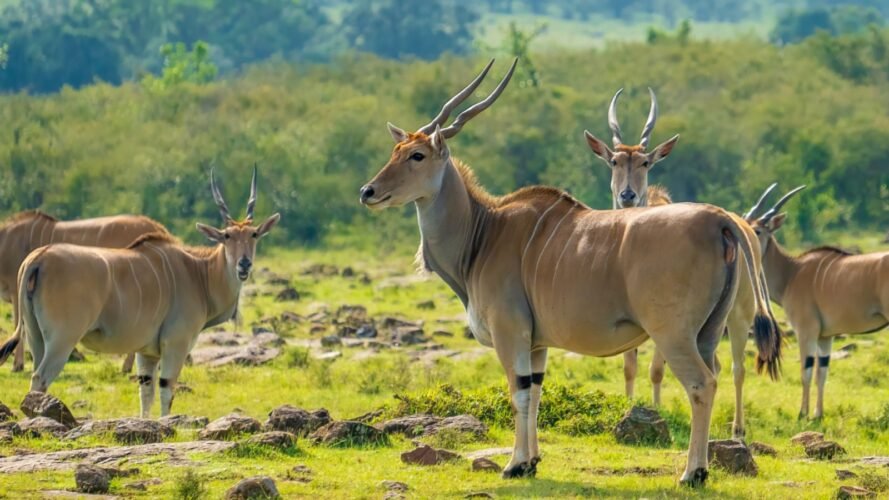
The common eland is the second-largest antelope in the world, with males weighing up to 2,000 pounds. These antelopes are not just large but also remarkably agile, able to jump over 8 feet from a standing start. Elands are found in grassland, mountain, sub-desert, and acacia savannah habitats across eastern and southern Africa.
Grevy’s Zebra
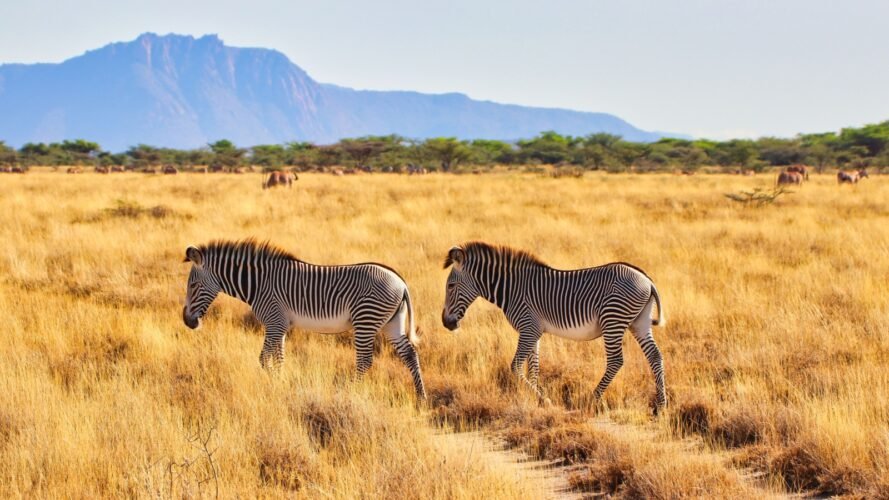
The Grevy’s zebra can weigh up to 990 pounds. Distinguished by their narrow stripes and white, furry bellies, these zebras are more donkey-like in appearance compared to other species. Grevy’s zebras are endangered and found in isolated areas in Kenya and Ethiopia.
African Lion
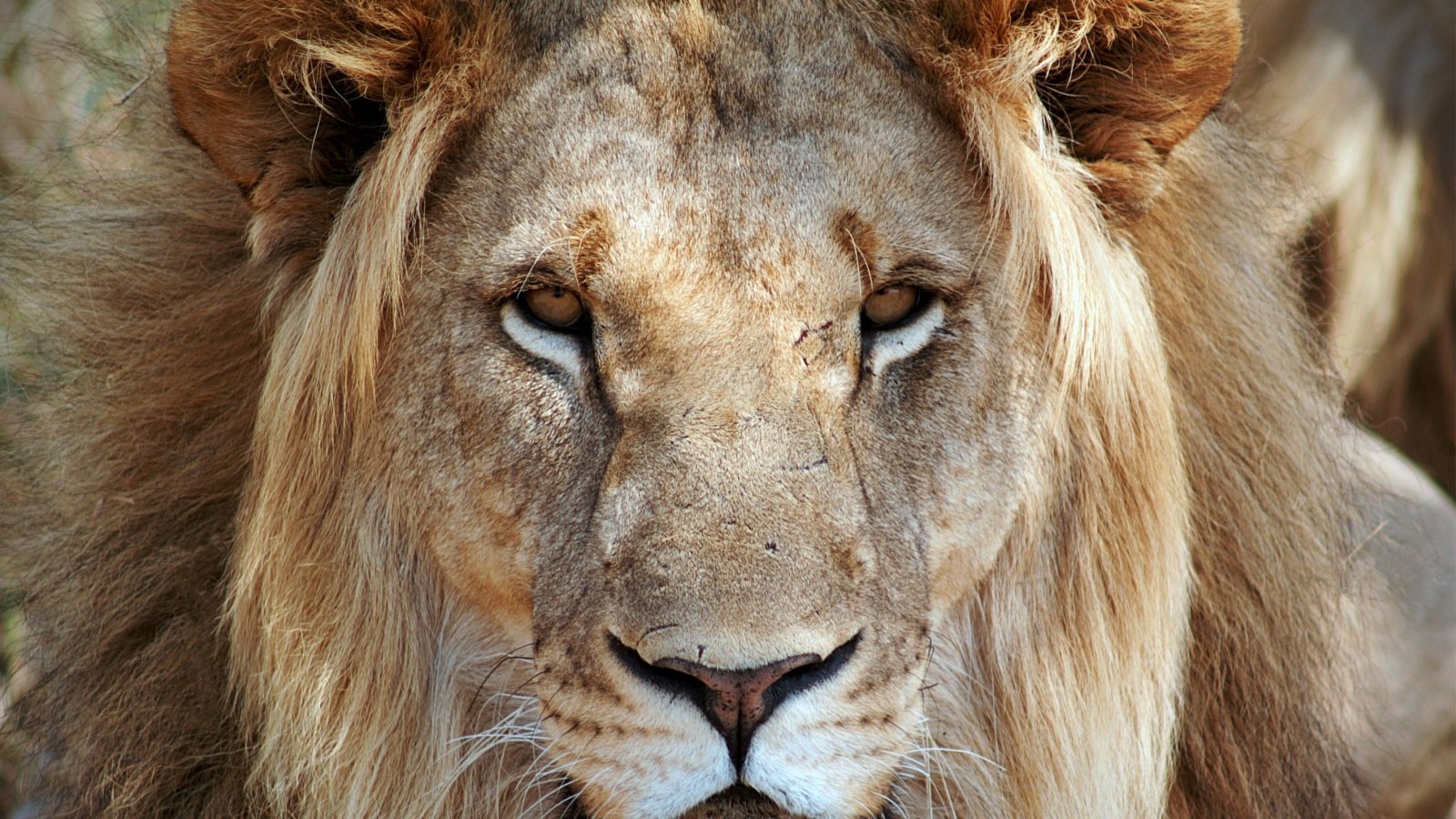
The African lion can weigh up to 500 pounds. Lions are the only cats that live in groups, known as prides, which are typically matriarchal and control vast territories. Their cooperative hunting strategies allow them to take down large herbivores like wildebeests and zebras.
Lappet-Faced Vulture
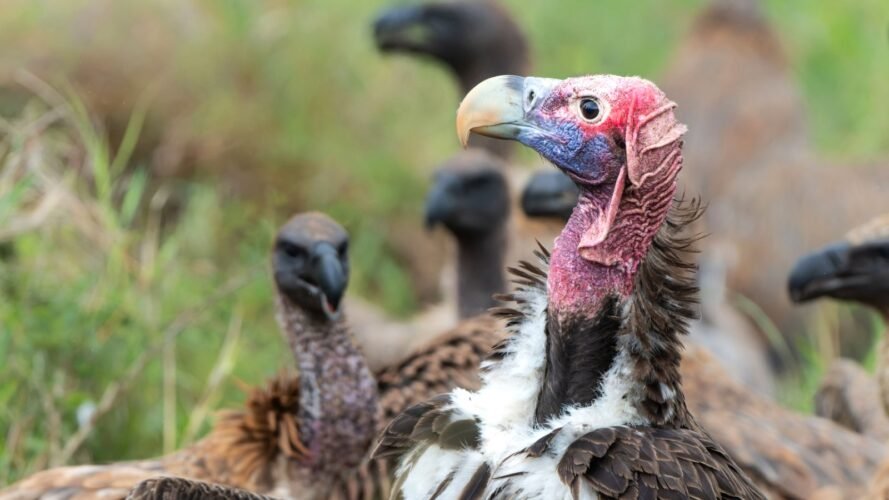
The lappet-faced vulture is one of the largest vultures in Africa, with a wingspan reaching up to 9.5 feet. They are key to the ecosystem, acting as scavengers that clean up dead animal carcasses, preventing the spread of disease. Their massive size and powerful beak allow them to tear through tough skin and muscle, which smaller scavengers cannot manage.
African Wild Dog
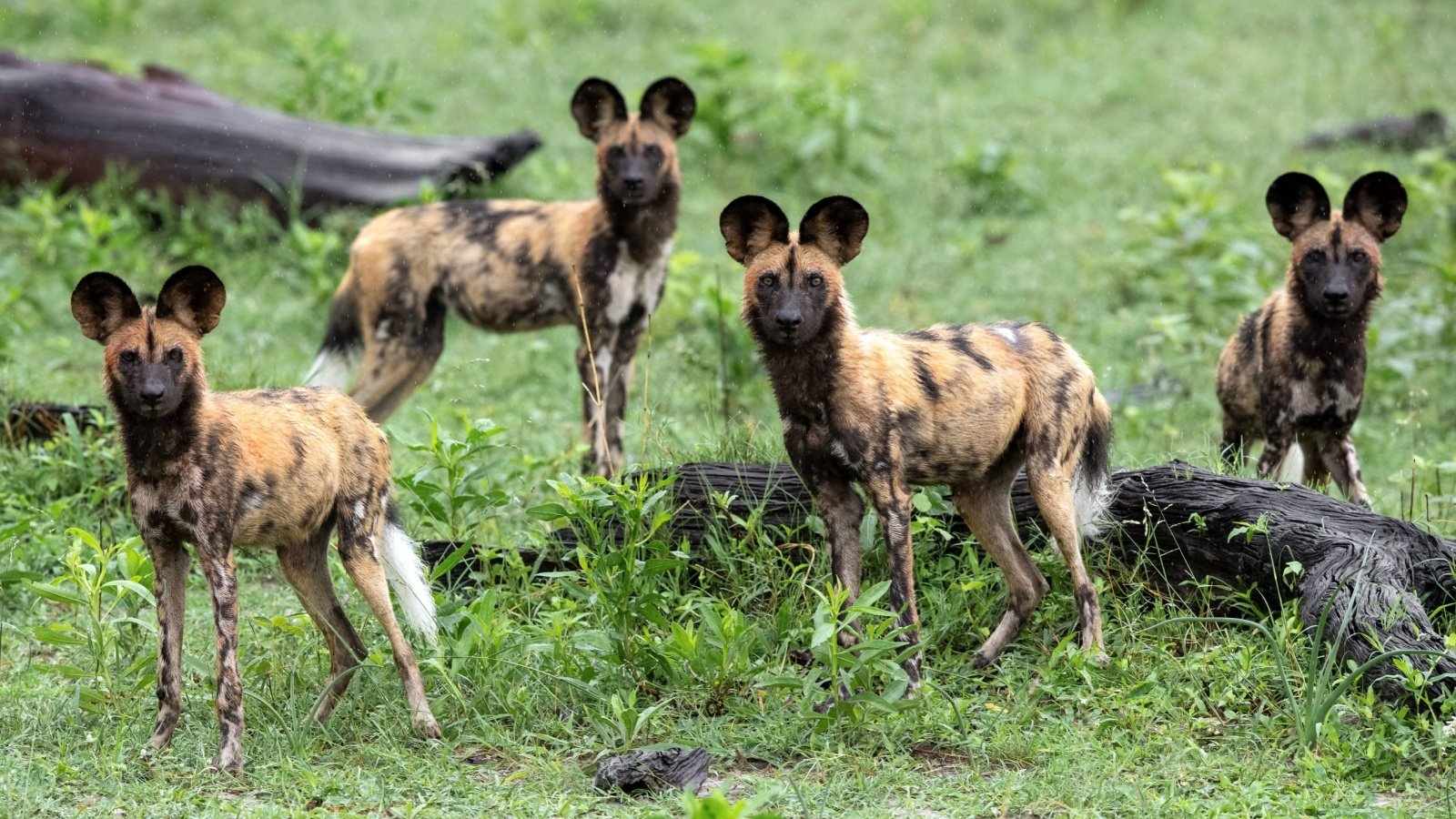
African wild dogs are impressive pack hunters known for their endurance and speed. An adult can weigh up to 79 pounds. Their social structure is complex, and they are known for their high success rate in hunts due to their cooperative strategies and communication.
Anhinga
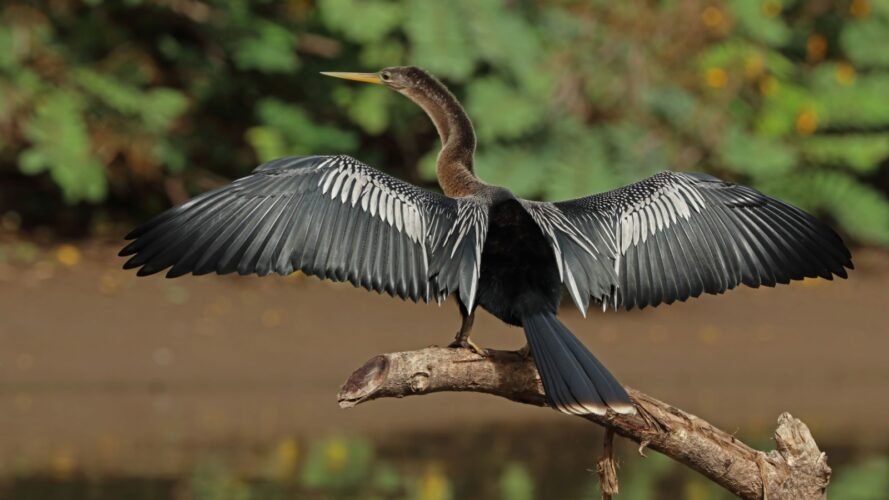
Sometimes called the snakebird for its long neck, the Anhinga is a large water bird that dives for fish and can be found in freshwater ponds and swamps across Africa. An adult Anhinga can weigh up to 3.3 pounds and has a wingspan of up to 4 feet.
Nile Monitor
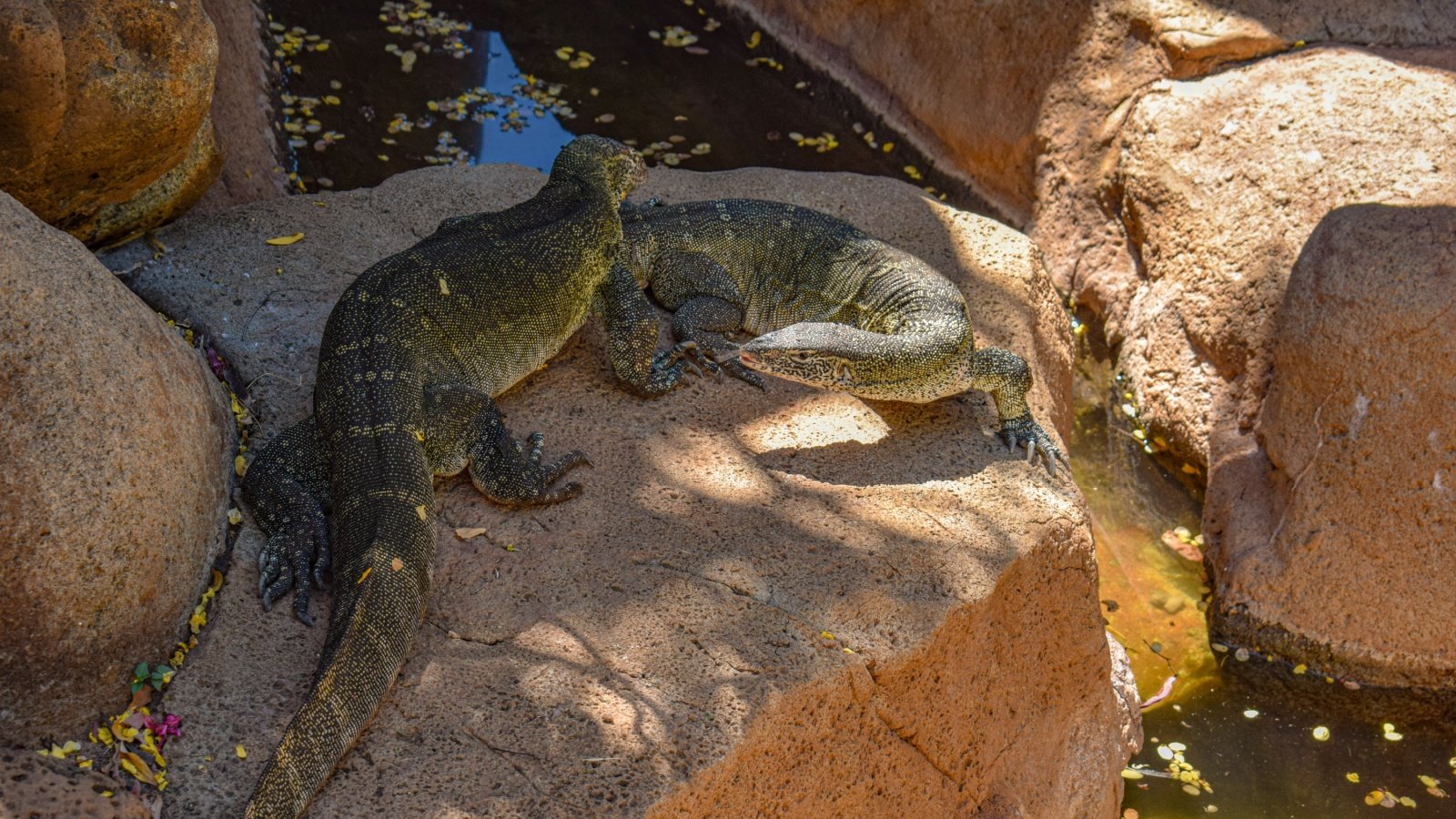
This large lizard can reach lengths of up to 7 feet, making it one of the largest lizards in Africa. Nile monitors are excellent swimmers and climbers, feeding on fish, birds, and small mammals. They are known for their aggressive behavior and ability to defend themselves against larger predators.









Excellent blog! Do you have any suggestions for aspiring writers? I’m hoping to start my own site soon but I’m a little lost on everything. Would you suggest starting with a free platform like WordPress or go for a paid option? There are so many choices out there that I’m totally confused .. Any tips? Thanks!
Very interesting topic, regards for posting.
I am writing to let you know of the impressive experience my cousin’s child enjoyed checking your web page. She learned lots of issues, which include what it is like to possess a great giving mindset to get most people with ease know various tortuous subject areas. You actually surpassed my expectations. Thanks for coming up with these productive, dependable, educational and also fun tips on this topic to Mary.
I’d have to examine with you here. Which is not one thing I usually do! I take pleasure in reading a post that may make folks think. Additionally, thanks for permitting me to comment!
You have brought up a very wonderful details, regards for the post.
Hello.This post was really motivating, especially since I was searching for thoughts on this issue last couple of days.
At this time it looks like Expression Engine is the top blogging platform available right now. (from what I’ve read) Is that what you are using on your blog?
Thanks for any other informative web site. The place else could I get that kind of information written in such an ideal approach? I have a venture that I am just now running on, and I have been at the look out for such info.
Way cool, some valid points! I appreciate you making this article available, the rest of the site is also high quality. Have a fun.
I think this web site has got some real excellent information for everyone :D. “Calamity is the test of integrity.” by Samuel Richardson.
I have been surfing online more than three hours today, yet I never found any interesting article like yours. It’s pretty worth enough for me. In my view, if all web owners and bloggers made good content as you did, the web will be much more useful than ever before.
Hello very cool blog!! Man .. Excellent .. Amazing .. I will bookmark your website and take the feeds alsoKI am satisfied to search out a lot of helpful info here within the put up, we need develop more techniques in this regard, thanks for sharing. . . . . .
I like this weblog so much, bookmarked. “To hold a pen is to be at war.” by Francois Marie Arouet Voltaire.
Very efficiently written article. It will be valuable to anyone who usess it, including yours truly :). Keep up the good work – for sure i will check out more posts.
This web site is my inspiration , really superb pattern and perfect content material.
Hey there! Would you mind if I share your blog with my twitter group? There’s a lot of people that I think would really appreciate your content. Please let me know. Cheers
Undeniably believe that that you stated. Your favorite reason seemed to be on the net the simplest thing to take into account of. I say to you, I certainly get irked while other people consider issues that they plainly do not realize about. You controlled to hit the nail upon the top as smartly as outlined out the entire thing with no need side effect , other people can take a signal. Will likely be again to get more. Thanks
It’s really a great and useful piece of info. I’m satisfied that you just shared this useful information with us. Please keep us up to date like this. Thank you for sharing.
Youre so cool! I dont suppose Ive read anything like this before. So good to search out anyone with some authentic ideas on this subject. realy thank you for beginning this up. this website is one thing that is needed on the net, someone with a bit of originality. useful job for bringing one thing new to the web!
Thanks for another informative web site. Where else could I get that type of information written in such a perfect way? I’ve a project that I am just now working on, and I have been on the look out for such information.
Thankyou for this marvelous post, I am glad I found this site on yahoo.
I think other site proprietors should take this web site as an model, very clean and great user genial style and design, as well as the content. You are an expert in this topic!
you’re really a good webmaster. The web site loading speed is incredible. It seems that you are doing any unique trick. Moreover, The contents are masterwork. you’ve done a magnificent job on this topic!
Keep up the wonderful piece of work, I read few articles on this internet site and I think that your web site is rattling interesting and has circles of good info .
I’d constantly want to be update on new articles on this internet site, saved to favorites! .
I was looking at some of your articles on this site and I conceive this web site is real informative! Keep posting.
I loved as much as you will receive carried out right here. The sketch is attractive, your authored subject matter stylish. nonetheless, you command get bought an impatience over that you wish be delivering the following. unwell unquestionably come more formerly again since exactly the same nearly very often inside case you shield this hike.
Thanks for some other magnificent post. The place else may anyone get that type of information in such a perfect means of writing? I have a presentation next week, and I am at the look for such information.
Great line up. We will be linking to this great article on our site. Keep up the good writing.
Pretty section of content. I just stumbled upon your web site and in accession capital to assert that I acquire actually enjoyed account your blog posts. Any way I’ll be subscribing to your augment and even I achievement you access consistently rapidly.
Its superb as your other posts : D, thankyou for putting up.
When I originally commented I clicked the “Notify me when new comments are added” checkbox and now each time a comment is added I get several e-mails with the same comment. Is there any way you can remove people from that service? Bless you!
As I site possessor I believe the content material here is rattling excellent , appreciate it for your efforts. You should keep it up forever! Good Luck.
It¦s really a great and helpful piece of info. I¦m glad that you just shared this useful info with us. Please keep us informed like this. Thank you for sharing.
You have brought up a very great details , thanks for the post.
I like what you guys are up too. Such smart work and reporting! Carry on the superb works guys I have incorporated you guys to my blogroll. I think it’ll improve the value of my web site 🙂
I’ve been exploring for a little for any high quality articles or blog posts on this kind of area . Exploring in Yahoo I at last stumbled upon this web site. Reading this info So i am happy to convey that I’ve an incredibly good uncanny feeling I discovered exactly what I needed. I most certainly will make certain to don’t forget this website and give it a glance regularly.
Of course, what a great blog and informative posts, I definitely will bookmark your blog.Have an awsome day!
I’ve been absent for a while, but now I remember why I used to love this site. Thanks, I will try and check back more frequently. How frequently you update your web site?
I’m still learning from you, but I’m trying to reach my goals. I certainly love reading everything that is posted on your website.Keep the aarticles coming. I enjoyed it!
Some genuinely nice and utilitarian info on this web site, also I think the layout contains excellent features.
As I web site possessor I believe the content material here is rattling wonderful , appreciate it for your efforts. You should keep it up forever! Good Luck.
The next time I read a blog, I hope that it doesnt disappoint me as much as this one. I mean, I know it was my choice to read, but I actually thought youd have something interesting to say. All I hear is a bunch of whining about something that you could fix if you werent too busy looking for attention.
It is really a great and helpful piece of information. I am glad that you shared this useful info with us. Please keep us up to date like this. Thanks for sharing.
Hello. impressive job. I did not imagine this. This is a impressive story. Thanks!
Good day! This is kind of off topic but I need some help from an established blog. Is it hard to set up your own blog? I’m not very techincal but I can figure things out pretty quick. I’m thinking about setting up my own but I’m not sure where to begin. Do you have any ideas or suggestions? Cheers
Good ?V I should definitely pronounce, impressed with your website. I had no trouble navigating through all the tabs and related information ended up being truly simple to do to access. I recently found what I hoped for before you know it at all. Reasonably unusual. Is likely to appreciate it for those who add forums or something, site theme . a tones way for your client to communicate. Nice task..
I have learn a few good stuff here. Certainly value bookmarking for revisiting. I wonder how so much effort you put to make such a fantastic informative website.
Deference to website author, some great information .
I’ve been browsing online greater than three hours nowadays, yet I never found any fascinating article like yours. It is lovely worth sufficient for me. In my view, if all webmasters and bloggers made excellent content as you probably did, the web shall be a lot more useful than ever before.
I’d have to verify with you here. Which is not one thing I normally do! I take pleasure in studying a publish that will make folks think. Also, thanks for allowing me to comment!
Sweet blog! I found it while browsing on Yahoo News. Do you have any tips on how to get listed in Yahoo News? I’ve been trying for a while but I never seem to get there! Thank you
magnificent points altogether, you simply gained a new reader. What would you recommend in regards to your post that you made a few days ago? Any positive?
I really treasure your piece of work, Great post.
Enjoyed examining this, very good stuff, appreciate it. “Golf isn’t a game, it’s a choice that one makes with one’s life.” by Charles Rosin.
It is in point of fact a nice and helpful piece of info. I am satisfied that you simply shared this helpful info with us. Please keep us informed like this. Thanks for sharing.
You really make it seem so easy with your presentation but I find this topic to be really something which I think I would never understand. It seems too complicated and extremely broad for me. I’m looking forward for your next post, I will try to get the hang of it!
I feel this is among the such a lot vital information for me. And i’m happy studying your article. But should statement on some common issues, The website style is wonderful, the articles is actually nice : D. Good process, cheers
I really like your writing style, fantastic info, appreciate it for posting :D. “Faith is a continuation of reason.” by William Adams.
you have a great blog here! would you like to make some invite posts on my blog?
Someone essentially help to make seriously posts I would state. This is the first time I frequented your website page and thus far? I amazed with the research you made to create this particular publish incredible. Great job!
I simply couldn’t depart your website prior to suggesting that I really enjoyed the standard info an individual supply on your visitors? Is gonna be again steadily in order to check up on new posts.
Its like you read my mind! You seem to know a lot about this, like you wrote the book in it or something. I think that you could do with a few pics to drive the message home a bit, but other than that, this is excellent blog. A fantastic read. I’ll certainly be back.
Great wordpress blog here.. It’s hard to find quality writing like yours these days. I really appreciate people like you! take care
I think you have remarked some very interesting details, appreciate it for the post.
An interesting discussion is worth comment. I think that you should write more on this topic, it might not be a taboo subject but generally people are not enough to speak on such topics. To the next. Cheers
Just what I was searching for, appreciate it for posting.
I got good info from your blog
Yeah bookmaking this wasn’t a bad determination great post! .
You actually make it seem really easy together with your presentation however I find this matter to be actually something that I believe I’d by no means understand. It seems too complicated and very wide for me. I am having a look forward to your subsequent put up, I will attempt to get the dangle of it!
Some genuinely superb info , Glad I found this. “Leaders must encourage their organizations to dance to forms of music yet to be heard.” by Warren Bennis.
You are my intake, I have few web logs and very sporadically run out from to brand : (.
Thanks , I’ve recently been searching for info about this topic for ages and yours is the best I’ve discovered so far. But, what about the bottom line? Are you sure about the source?
Some genuinely nice and useful information on this web site, likewise I think the style holds good features.
Very interesting details you have mentioned, appreciate it for putting up.
Heya i’m for the primary time here. I found this board and I find It really useful & it helped me out much. I hope to offer something again and help others such as you aided me.
Somebody essentially help to make seriously posts I would state. This is the first time I frequented your web page and thus far? I surprised with the research you made to create this particular publish incredible. Fantastic job!
Hello there, I found your web site via Google at the same time as searching for a comparable topic, your website got here up, it seems good. I’ve bookmarked it in my google bookmarks.
Hiya, I’m really glad I’ve found this info. Today bloggers publish only about gossips and net and this is actually irritating. A good website with interesting content, this is what I need. Thank you for keeping this web-site, I’ll be visiting it. Do you do newsletters? Can’t find it.
I wanted to thank you for this great read!! I definitely enjoying every little bit of it I have you bookmarked to check out new stuff you post…
so much fantastic info on here, : D.
Hello! This is my first visit to your blog! We are a group of volunteers and starting a new project in a community in the same niche. Your blog provided us useful information to work on. You have done a wonderful job!
hello!,I really like your writing very so much! proportion we be in contact more about your article on AOL? I require a specialist on this area to unravel my problem. Maybe that’s you! Looking ahead to see you.
hello!,I like your writing very much! proportion we communicate extra approximately your post on AOL? I need a specialist on this area to solve my problem. May be that’s you! Taking a look ahead to peer you.
Good day! Do you know if they make any plugins to assist with Search Engine Optimization? I’m trying to get my blog to rank for some targeted keywords but I’m not seeing very good success. If you know of any please share. Kudos!
F*ckin’ amazing issues here. I am very glad to see your article. Thank you a lot and i am looking ahead to contact you. Will you please drop me a mail?
Hi , I do believe this is an excellent blog. I stumbled upon it on Yahoo , i will come back once again. Money and freedom is the best way to change, may you be rich and help other people.
Sweet web site, super pattern, rattling clean and employ friendly.
Wow! This can be one particular of the most helpful blogs We’ve ever arrive across on this subject. Basically Great. I am also a specialist in this topic so I can understand your hard work.
Very nice post. I just stumbled upon your weblog and wished to say that I’ve really enjoyed browsing your blog posts. In any case I will be subscribing to your rss feed and I hope you write again soon!
Can I simply say what a relief to find someone who truly is aware of what theyre speaking about on the internet. You undoubtedly know how to carry a difficulty to light and make it important. Extra folks must learn this and understand this facet of the story. I cant imagine youre not more common because you definitely have the gift.
As a Newbie, I am continuously searching online for articles that can benefit me. Thank you
hello!,I like your writing so much! share we communicate more about your article on AOL? I require a specialist on this area to solve my problem. Maybe that’s you! Looking forward to see you.
This really answered my drawback, thanks!
You have brought up a very wonderful details , regards for the post.
Some really good content on this internet site, thanks for contribution.
Thanks for another magnificent article. Where else could anybody get that kind of info in such a perfect way of writing? I’ve a presentation next week, and I am on the look for such info.
Good post. I learn one thing more challenging on completely different blogs everyday. It is going to all the time be stimulating to read content material from other writers and observe a bit of something from their store. I’d want to use some with the content material on my blog whether you don’t mind. Natually I’ll offer you a hyperlink on your internet blog. Thanks for sharing.
An interesting discussion is value comment. I believe that you must write more on this topic, it won’t be a taboo topic however usually people are not sufficient to speak on such topics. To the next. Cheers
I have been absent for a while, but now I remember why I used to love this blog. Thank you, I will try and check back more often. How frequently you update your site?
Thank you for every one of your work on this web page. My mom really likes participating in investigation and it is simple to grasp why. Most of us learn all about the dynamic ways you convey helpful tips through your blog and as well foster response from some others on this content then my simple princess is without question understanding a lot. Have fun with the remaining portion of the year. Your carrying out a glorious job.
What i don’t realize is actually how you’re not really much more well-liked than you may be now. You’re so intelligent. You realize thus considerably relating to this subject, produced me personally consider it from numerous varied angles. Its like women and men aren’t fascinated unless it’s one thing to accomplish with Lady gaga! Your own stuffs great. Always maintain it up!
Regards for this post, I am a big big fan of this internet site would like to continue updated.
This really answered my problem, thank you!
I like this site because so much useful material on here : D.
I was just seeking this info for a while. After 6 hours of continuous Googleing, at last I got it in your site. I wonder what is the lack of Google strategy that don’t rank this type of informative websites in top of the list. Generally the top web sites are full of garbage.
You are a very smart individual!
Really nice design and style and great subject matter, practically nothing else we require : D.
I like what you guys are up also. Such smart work and reporting! Keep up the superb works guys I?¦ve incorporated you guys to my blogroll. I think it will improve the value of my site 🙂
Hi there, simply was aware of your blog through Google, and found that it’s really informative. I am going to watch out for brussels. I will appreciate for those who proceed this in future. Lots of other folks will probably be benefited from your writing. Cheers!
I and also my guys were checking the good thoughts located on your website and at once I got an awful feeling I had not expressed respect to the website owner for those strategies. The women were certainly excited to learn them and have in effect truly been having fun with them. Thanks for simply being really considerate and then for choosing varieties of superb things most people are really desirous to discover. My very own sincere apologies for not expressing gratitude to sooner.
I’ve read several good stuff here. Certainly worth bookmarking for revisiting. I surprise how much effort you put to create such a fantastic informative website.
Hello.This article was really fascinating, especially since I was browsing for thoughts on this subject last Wednesday.
Great website! I am loving it!! Will come back again. I am taking your feeds also
Very interesting information!Perfect just what I was searching for!
I really appreciate this post. I’ve been looking everywhere for this! Thank goodness I found it on Bing. You’ve made my day! Thx again
I loved as much as you will receive carried out right here. The sketch is attractive, your authored material stylish. nonetheless, you command get bought an nervousness over that you wish be delivering the following. unwell unquestionably come more formerly again since exactly the same nearly very often inside case you shield this increase.
Can I just say what a relief to find someone who actually knows what theyre talking about on the internet. You definitely know how to bring an issue to light and make it important. More people need to read this and understand this side of the story. I cant believe youre not more popular because you definitely have the gift.
But wanna state that this is very helpful, Thanks for taking your time to write this.
Good day very nice website!! Man .. Beautiful .. Amazing .. I will bookmark your site and take the feeds additionallyKI am happy to find numerous helpful info right here in the post, we’d like work out extra techniques in this regard, thank you for sharing. . . . . .
Woah! I’m really digging the template/theme of this website. It’s simple, yet effective. A lot of times it’s very hard to get that “perfect balance” between superb usability and appearance. I must say you have done a superb job with this. In addition, the blog loads very fast for me on Chrome. Excellent Blog!
Well I definitely liked studying it. This information provided by you is very constructive for proper planning.
Sweet site, super design and style, rattling clean and utilise genial.
Hello, i read your blog from time to time and i own a similar one and i was just curious if you get a lot of spam comments? If so how do you reduce it, any plugin or anything you can advise? I get so much lately it’s driving me insane so any support is very much appreciated.
Appreciating the time and energy you put into your website and in depth information you offer. It’s good to come across a blog every once in a while that isn’t the same unwanted rehashed information. Fantastic read! I’ve saved your site and I’m including your RSS feeds to my Google account.
Very interesting info !Perfect just what I was searching for! “If you want to test your memory, try to recall what you were worrying about one year ago today.” by Rotarian.
Hello there, I found your website by the use of Google at the same time as searching for a related matter, your website got here up, it appears to be like great. I’ve bookmarked it in my google bookmarks.
I like what you guys are up too. Such intelligent work and reporting! Keep up the superb works guys I’ve incorporated you guys to my blogroll. I think it’ll improve the value of my site 🙂
This blog is definitely rather handy since I’m at the moment creating an internet floral website – although I am only starting out therefore it’s really fairly small, nothing like this site. Can link to a few of the posts here as they are quite. Thanks much. Zoey Olsen
The content is engaging and well-structured, keeping visitors interested.
This site truly stands out as a great example of quality web design and performance.
You completed a few fine points there. I did a search on the subject matter and found mainly people will agree with your blog.
Appreciate it for all your efforts that you have put in this. very interesting info .
Your place is valueble for me. Thanks!…
The content is well-organized and highly informative.
Hi, Neat post. There is a problem with your site in internet explorer, would check this… IE still is the market leader and a good portion of people will miss your wonderful writing due to this problem.
Hiya, I’m really glad I’ve found this info. Nowadays bloggers publish just about gossips and net and this is really annoying. A good website with exciting content, this is what I need. Thanks for keeping this web-site, I’ll be visiting it. Do you do newsletters? Can not find it.
Whoa! This blog looks exactly like my old one! It’s on a completely different subject but it has pretty much the same page layout and design. Wonderful choice of colors!
This website is amazing, with a clean design and easy navigation.
Your style is so unique compared to many other people. Thank you for publishing when you have the opportunity,Guess I will just make this bookmarked.2
Oh my goodness! an incredible article dude. Thank you Nevertheless I am experiencing subject with ur rss . Don’t know why Unable to subscribe to it. Is there anyone getting an identical rss problem? Anybody who knows kindly respond. Thnkx
The design and usability are top-notch, making everything flow smoothly.
Aw, this was a really nice post. In concept I want to put in writing like this moreover – taking time and actual effort to make an excellent article… however what can I say… I procrastinate alot and in no way seem to get one thing done.
The content is engaging and well-structured, keeping visitors interested.
Hiya very nice blog!! Man .. Beautiful .. Amazing .. I’ll bookmark your site and take the feeds additionally…I am satisfied to seek out numerous useful info right here in the submit, we need develop extra techniques in this regard, thank you for sharing.
The Natural Mounjaro Recipe is more than just a diet—it’s a sustainable and natural approach to weight management and overall health.
Wow, this paragraph is good, my sister is analyzing these
kinnds off things, therefore I am going to inform her. https://Menbehealth.Wordpress.com/
The Natural Mounjaro Recipe is more than just a diet—it’s a sustainable and natural approach to weight management and overall health.
I’m really impressed by the speed and responsiveness.
I really appreciate this post. I have been looking everywhere for this! Thank goodness I found it on Bing. You have made my day! Thx again
Great site you have here but I was curious about if you knew of any message boards that cover the same topics discussed in this article? I’d really like to be a part of community where I can get responses from other knowledgeable individuals that share the same interest. If you have any suggestions, please let me know. Appreciate it!
This website is amazing, with a clean design and easy navigation.
The Natural Mounjaro Recipe is more than just a diet—it’s a sustainable and natural approach to weight management and overall health.
I truly enjoy looking through on this site, it contains good posts. “Beware lest in your anxiety to avoid war you obtain a master.” by Demosthenes.
I’m really impressed by the speed and responsiveness.
Great blog! Is your theme custom made or did you download it from somewhere? A theme like yours with a few simple tweeks would really make my blog shine. Please let me know where you got your theme. Thanks
The Ice Water Hack has gained popularity as a simple yet effective method for boosting metabolism and promoting weight loss.
PrimeBiome is a dietary supplement designed to support gut health by promoting a balanced microbiome, enhancing digestion, and boosting overall well-being.
The layout is visually appealing and very functional.
F*ckin’ remarkable things here. I am very satisfied to look your post. Thanks so much and i’m taking a look ahead to touch you. Will you kindly drop me a e-mail?
What¦s Going down i am new to this, I stumbled upon this I have found It positively useful and it has helped me out loads. I hope to give a contribution & aid different customers like its aided me. Great job.
Merely wanna input on few general things, The website design is perfect, the written content is real fantastic. “War is much too serious a matter to be entrusted to the military.” by Georges Clemenceau.
For thee reason that the admin of this website is
working, no doubt very shortly it ill be renowned, due
to its quality contents. https://www.Evilinvadersrecords.com.br/?p=21178
This site truly stands out as a great example of quality web design and performance.
Very interesting info!Perfect just what I was searching for!
A perfect blend of aesthetics and functionality makes browsing a pleasure.
The layout is visually appealing and very functional.
This website online is really a walk-by way of for all the data you wanted about this and didn’t know who to ask. Glimpse here, and also you’ll definitely uncover it.
The content is well-organized and highly informative.
I intended to post you that tiny note to help say thanks a lot over again about the amazing tips you have provided on this page. It has been so particularly open-handed with people like you in giving extensively exactly what a number of us might have advertised for an ebook to help with making some profit on their own, primarily considering the fact that you might have done it in the event you considered necessary. These basics also acted like the good way to be aware that the rest have a similar desire like my very own to see a lot more concerning this issue. I’m sure there are several more enjoyable instances in the future for people who discover your website.
I’ve been browsing online more than 3 hours as of late, but I never found any fascinating article like yours. It’s beautiful worth sufficient for me. Personally, if all site owners and bloggers made excellent content as you probably did, the internet might be much more useful than ever before.
Its like you read my thoughts! You appear to grasp a lot about this, like you wrote the e-book in it or something. I believe that you can do with a few percent to pressure the message home a little bit, however instead of that, this is magnificent blog. A great read. I’ll certainly be back.
As I web-site possessor I believe the content material here is rattling fantastic , appreciate it for your hard work. You should keep it up forever! Good Luck.
As a Newbie, I am always browsing online for articles that can be of assistance to me. Thank you
Hi, Neat post. There’s a problem with your web site in internet explorer, would test this… IE still is the market leader and a big portion of people will miss your great writing because of this problem.
Somebody essentially help to make seriously articles I would state. This is the first time I frequented your website page and thus far? I amazed with the research you made to create this particular publish amazing. Magnificent job!
Live concerts have a special magic. No recording can ever capture that raw energy of the crowd and the artist performing in the moment.
Good – I should certainly pronounce, impressed with your web site. I had no trouble navigating through all tabs as well as related info ended up being truly easy to do to access. I recently found what I hoped for before you know it in the least. Reasonably unusual. Is likely to appreciate it for those who add forums or anything, site theme . a tones way for your customer to communicate. Excellent task.
Thanx for the effort, keep up the good work Great work, I am going to start a small Blog Engine course work using your site I hope you enjoy blogging with the popular BlogEngine.net.Thethoughts you express are really awesome. Hope you will right some more posts.
Watching a sunset over the ocean is one of the most peaceful experiences in life. Nature has a way of reminding us how small but connected we all are.
Hi, I think your blog might be having browser compatibility issues. When I look at your blog in Firefox, it looks fine but when opening in Internet Explorer, it has some overlapping. I just wanted to give you a quick heads up! Other then that, fantastic blog!
Very nice post and right to the point. I am not sure if this is actually the best place to ask but do you people have any ideea where to employ some professional writers? Thx 🙂
Do you have a spam issue on this website; I also am a blogger, and I was wanting to know your situation; many of us have developed some nice methods and we are looking to exchange strategies with others, be sure to shoot me an e-mail if interested.
Nothing beats homemade pasta. The texture and flavor are just on another level compared to store-bought versions. Cooking from scratch is truly an art.
I love what you guys are usually up too. Such clever work and reporting! Keep up the wonderful works guys I’ve you guys to blogroll.
Watching a sunset over the ocean is one of the most peaceful experiences in life. Nature has a way of reminding us how small but connected we all are.
I cling on to listening to the newscast lecture about getting boundless online grant applications so I have been looking around for the most excellent site to get one. Could you advise me please, where could i acquire some?
Would love to always get updated outstanding website! .
You can definitely see your enthusiasm within the paintings you write. The arena hopes for even more passionate writers like you who aren’t afraid to say how they believe. All the time go after your heart.
As a Newbie, I am permanently searching online for articles that can benefit me. Thank you
Live concerts have a special magic. No recording can ever capture that raw energy of the crowd and the artist performing in the moment.
I just like the helpful info you provide to your articles. I’ll bookmark your weblog and take a look at again here regularly. I am moderately sure I’ll be told plenty of new stuff right here! Best of luck for the following!
Thanks for another informative website. Where else may I am getting that kind of information written in such a perfect method? I’ve a challenge that I am simply now operating on, and I’ve been on the glance out for such information.
I truly appreciate this post. I’ve been looking everywhere for this! Thank goodness I found it on Bing. You’ve made my day! Thank you again!
I’d forever want to be update on new blog posts on this web site, saved to fav! .
This actually answered my downside, thank you!
What’s Going down i am new to this, I stumbled upon this I’ve found It absolutely useful and it has helped me out loads. I’m hoping to give a contribution & aid different users like its aided me. Great job.
Can I just say what a relief to find someone who actually knows what theyre talking about on the internet. You definitely know how to bring an issue to light and make it important. More people need to read this and understand this side of the story. I cant believe youre not more popular because you definitely have the gift.
Have you ever thought about writing an ebook or guest authoring on other websites? I have a blog centered on the same topics you discuss and would really like to have you share some stories/information. I know my viewers would enjoy your work. If you are even remotely interested, feel free to shoot me an e-mail.
Hey, I think your site might be having browser compatibility issues. When I look at your blog in Firefox, it looks fine but when opening in Internet Explorer, it has some overlapping. I just wanted to give you a quick heads up! Other then that, superb blog!
You have brought up a very great details , thanks for the post.
Hi there, just became aware of your blog through Google, and found that it is really informative. I’m gonna watch out for brussels. I’ll appreciate if you continue this in future. Many people will be benefited from your writing. Cheers!
You made some decent points there. I regarded on the web for the problem and located most people will associate with together with your website.
Thanks so much for giving everyone a very superb chance to read critical reviews from here. It is usually very excellent and full of a great time for me and my office friends to visit your blog at the very least 3 times per week to find out the latest guides you have. And of course, I’m also at all times satisfied with the mind-boggling suggestions you give. Selected 3 tips in this article are certainly the best we have ever had.
It is actually a nice and useful piece of information. I’m satisfied that you just shared this useful information with us. Please keep us informed like this. Thanks for sharing.
Howdy very cool blog!! Man .. Beautiful .. Amazing .. I’ll bookmark your web site and take the feeds also…I am happy to search out numerous useful info here in the post, we want work out extra techniques in this regard, thanks for sharing.
Great write-up, I¦m normal visitor of one¦s web site, maintain up the nice operate, and It is going to be a regular visitor for a long time.
I love your blog.. very nice colors & theme. Did you create this website yourself? Plz reply back as I’m looking to create my own blog and would like to know wheere u got this from. thanks
As a Newbie, I am always searching online for articles that can benefit me. Thank you
Everything is very open and very clear explanation of issues. was truly information. Your website is very useful. Thanks for sharing.
I was wondering if you ever considered changing the page layout of your site? Its very well written; I love what youve got to say. But maybe you could a little more in the way of content so people could connect with it better. Youve got an awful lot of text for only having one or two images. Maybe you could space it out better?
Mitolyn is a cutting-edge natural dietary supplement designed to support effective weight loss and improve overall wellness.
Pretty! This was a really wonderful post. Thank you for your provided information.
Mitolyn is a cutting-edge natural dietary supplement designed to support effective weight loss and improve overall wellness.
whoah this weblog is magnificent i really like reading your posts. Keep up the good work! You already know, lots of persons are searching round for this info, you can help them greatly.
Greetings! Very helpful advice on this article! It is the little changes that make the biggest changes. Thanks a lot for sharing!
Your place is valueble for me. Thanks!…
I¦ve recently started a blog, the information you offer on this website has helped me tremendously. Thank you for all of your time & work.
I have to show my passion for your generosity in support of those who must have assistance with this study. Your personal commitment to getting the solution all-around had been wonderfully useful and have surely encouraged workers much like me to reach their goals. This valuable hints and tips indicates much a person like me and even further to my colleagues. Warm regards; from each one of us.
PrimeBiome is a dietary supplement designed to support gut health by promoting a balanced microbiome, enhancing digestion, and boosting overall well-being.
Good info. Lucky me I reach on your website by accident, I bookmarked it.
At this time it appears like Drupal is the preferred blogging platform available right now. (from what I’ve read) Is that what you are using on your blog?
There is obviously a bunch to realize about this. I suppose you made certain good points in features also.
I simply couldn’t go away your site before suggesting that I extremely loved the standard info an individual provide in your guests? Is going to be again continuously to check up on new posts
The Natural Mounjaro Recipe is more than just a diet—it’s a sustainable and natural approach to weight management and overall health.
پارتیشن سازه ، تولید کننده انواع پارتیشن اداری و سایر دکوراسیون اداری، با حدود سه دهه سابقه. با افتخار مجرئ انواع پروژهها در اکثریت شرکتها و ادارات. سفارش مستقیم از تولید کننده بدون واسطه
The next time I learn a weblog, I hope that it doesnt disappoint me as a lot as this one. I mean, I do know it was my choice to learn, but I truly thought youd have something interesting to say. All I hear is a bunch of whining about something that you would repair when you werent too busy looking for attention.
You have mentioned very interesting details! ps decent website . “Justice is the truth in action.” by Jeseph Joubert.
The Natural Mounjaro Recipe is more than just a diet—it’s a sustainable and natural approach to weight management and overall health.
I have not checked in here for a while as I thought it was getting boring, but the last few posts are great quality so I guess I?¦ll add you back to my everyday bloglist. You deserve it my friend 🙂
Can I just say what a relief to find someone who actually knows what theyre talking about on the internet. You definitely know how to bring an issue to light and make it important. More people need to read this and understand this side of the story. I cant believe youre not more popular because you definitely have the gift.
I’m really enjoying the design and layout of your site. It’s a very easy on the eyes which makes it much more pleasant for me to come here and visit more often. Did you hire out a designer to create your theme? Excellent work!
Nice blog here! Also your website loads up fast! What host are you using? Can I get your affiliate link to your host? I wish my web site loaded up as fast as yours lol
Great site! I am loving it!! Will come back again. I am taking your feeds also.
I like this blog very much, Its a very nice position to read and receive info . “Perpetual optimism is a force multiplier.” by Colin Powell.
Some really interesting info , well written and generally user pleasant.
Hello there, You have performed an excellent job. I’ll certainly digg it and personally recommend to my friends. I’m sure they’ll be benefited from this web site.
There are some interesting cut-off dates in this article but I don’t know if I see all of them middle to heart. There is some validity but I’ll take hold opinion until I look into it further. Good article , thanks and we wish more! Added to FeedBurner as properly
ProDentim is a cutting-edge oral health supplement designed to improve dental and gum health by leveraging natural probiotics and nutrientes.
I like what you guys are up also. Such clever work and reporting! Keep up the excellent works guys I?¦ve incorporated you guys to my blogroll. I think it will improve the value of my website 🙂
Hi there very nice web site!! Guy .. Beautiful .. Amazing .. I’ll bookmark your site and take the feeds additionallyKI’m satisfied to seek out numerous helpful information here in the publish, we’d like work out more strategies on this regard, thank you for sharing. . . . . .
Some times its a pain in the ass to read what people wrote but this website is really user friendly! .
I like this post, enjoyed this one thanks for posting. “The world is round and the place which may seem like the end may also be only the beginning.” by George Baker.
Thanks for the marvelous posting! I quite enjoyed reading it, you’re a great author.I will be sure to bookmark your blog and may come back in the future. I want to encourage one to continue your great posts, have a nice holiday weekend!
Some really interesting information, well written and generally user friendly.
Really Appreciate this post, can you make it so I get an update sent in an email whenever there is a fresh article?
Hello! I just would like to give a huge thumbs up for the great info you have here on this post. I will be coming back to your blog for more soon.
I would like to thnkx for the efforts you have put in writing this blog. I am hoping the same high-grade blog post from you in the upcoming as well. In fact your creative writing abilities has inspired me to get my own blog now. Really the blogging is spreading its wings quickly. Your write up is a good example of it.
You should take part in a contest for one of the best blogs on the web. I will recommend this site!
you’ve got an ideal blog right here! would you like to make some invite posts on my blog?
I think this is among the most vital info for me. And i am glad reading your article. But should remark on few general things, The website style is ideal, the articles is really great : D. Good job, cheers
Some truly interesting information, well written and broadly speaking user friendly.
Definitely, what a splendid website and informative posts, I definitely will bookmark your blog.Have an awsome day!
I very glad to find this web site on bing, just what I was looking for : D likewise saved to my bookmarks.
I’ve been exploring for a little bit for any high-quality articles or blog posts on this sort of area . Exploring in Yahoo I at last stumbled upon this web site. Reading this info So i’m happy to convey that I’ve an incredibly good uncanny feeling I discovered exactly what I needed. I most certainly will make certain to don’t forget this website and give it a glance on a constant basis.
Can I just say what a relief to seek out someone who really is aware of what theyre talking about on the internet. You definitely know tips on how to deliver an issue to light and make it important. More people must read this and understand this facet of the story. I cant consider youre not more widespread since you undoubtedly have the gift.
Only wanna input that you have a very decent site, I like the design and style it actually stands out.
I genuinely enjoy looking at on this website , it has got good articles. “Beauty in things exist in the mind which contemplates them.” by David Hume.
You are my breathing in, I own few blogs and sometimes run out from to brand.
I am really impressed together with your writing skills as neatly as with the structure for your blog. Is that this a paid subject or did you modify it your self? Anyway stay up the nice high quality writing, it is rare to peer a great weblog like this one these days..